
Story highlights:
According to research firm CB Insights, 29% of businesses fail because they run out of cash. No money means no marketing which means no sales which means no money. It’s a vicious cycle.
(Lack of cash is actually the #2 cause of failure, but we’ll talk about #1 later.)
For the solo attorney, maintaining cashflow is particularly tough. Time crunches, ethics rules, and lack of sales training combine to slow new sales. Without a constant funnel of paying clients, firms fold.
But obsession with cashflow can also lead to short-term thinking that’ll undo your firm. For example, a paid leads company once argued to me that they’d delivered $5,000 in billables to my firm while costing only $2,500 – an incredible $2,500 gain!
That’s not profit, I explained to the rep as I cancelled my service, as I still had to service all of the cases. If I calculated the cost of my own labor, that $2,500 gain actually represented a loss.
There are many ways to make money; there are far fewer ways to make a profit. Solos can’t simply chase cash. You need to be strategic.
If you want your firm to grow in a healthy way, you’ll want to focus on profit, and that means paying less for a pipeline of higher quality work.
[bctt tweet=”There are many ways to make money; there are far fewer ways to make a profit. Solos can’t simply chase cash. You need to be strategic.”]Enter referral marketing.
Lawyers have extolled the magic bullet-ness of referral marketing for centuries. Do good work, the argument goes, and the news will spread. Former clients will sing your praises and new clients will find you.
The data may actually support that argument. Professors at the Wharton School and Goethe University proved that referred clients “generate higher profit margins, are more loyal and show a higher customer lifetime value.”
Consumers aren’t passively waiting to be referred, either. As 2017’s Clio Legal Trends Report showed, 62% of consumers sought referrals from friends and family before hiring an attorney. 31% sought referrals from other attorneys. Lawyers who obtain these referrals stand a good chance of turning them into profitable work.
And lawyers are responding. Clio’s 2018 report calculates that their solo and small firm customers spend upwards of 1.4 hours a day building referral networks. That’s nearly as many hours as Clio found those lawyers are billing.
We know that referrals lead to highly profitable work, we know prospective clients are seeking referrals, and we know lawyers spend lots of time building referral networks. All’s well then, right? Apparently not.
As Bob Ambrogi reported last year, solo attorneys see not getting new clients as their biggest threat. Their second greatest worry is the downward pressure new clients put on pricing.
So, despite lawyers’ focus on referral marketing, and the profits such marketing promises, they’re not seeing results. According to their own assessments, solo attorneys are either not getting enough clients or they’re not getting profitable clients.
[bctt tweet=”We know that referrals lead to highly profitable work, we know prospective clients are seeking referrals, and we know lawyers spend lots of time building referral networks. All’s well then, right? Apparently not.”]Where’s the disconnect? Why spend nearly 20% of your day on an activity that doesn’t deliver promised results?
It’s time to reevaluate your beliefs about referrals.
There’s a whole world of people out there who don’t care about what you do.
That’s harsh, but it gives you a sense of the task ahead. A tiny fraction of humanity is invested enough in your success to promote it. Most people require persuasion. They need to be made to care.
[bctt tweet=”There’s a whole world of people out there who don’t care about what you do. That’s harsh, but it gives you a sense of the task ahead.”]As an owner, then, your primary task is to make sure those uncomfortable conversations happen as often as possible. You need someone who does care about your business to sit down with someone who doesn’t care and move them closer to trusting you. And you need that to happen often.
That’s a big ask, but a requirement for survival.
In sales training, they call these awkward conversations between people who care about your company and people who don’t “prospecting.” And, like panhandlers lining rivers in the Old West, you’ll find that prospecting rarely yields results.
Here’s how sales trainer Jeb Blount put it in his book Fanatical Prospecting:
[P]rospecting is hard, grueling, rejection-dense work. There is no sugarcoating it. Prospecting sucks.
For solo attorneys, the prospecting environment is even tougher than for the salespeople Blount aims to motivate. His advice – “You have to pick up the phone, knock on doors, make presentations, and ask for business” – can lead to a swift kick from the advertising rules committee at your local bar.

And yet those uncomfortable conversations are the lifeblood of your business. Without opportunities to move people from the don’t-care-about-you pool to the buy-from-you bucket, someone needs to engage.
That’s where your referral system comes in.
Fanatical referrers can do the prospecting work that you cannot, and they can do it at a larger scale. Whatever the size of your marketing and sales team (which is probably just you), you can’t match the impact of a group of brand advocates engaging in uncomfortable conversations on your behalf.
The question, then, is how to cultivate and empower that group of advocates. We’ll cover that in three steps in this article.
Before we do, though, I want to revisit a concept I’ve written a lot about recently: the circles of social capital that will make this effort work.
There’s a lot to study when it comes to social capital. In general, it refers to your networks and the economic and personal power that comes from them.
More broadly, the Organisation for Economic Co-operation and Development defines social capital as “networks together with shared norms, values and understandings that facilitate co-operation within or among groups.”
The point here is that what we often take for granted – the connections we share with others – are a major concern for groups who care about economic development, like the OECD.
They know that connections create value, and it’s vital that you understand how your social circles bring value to your law firm.
For simplicity’s sake, I want to define the three social circles that’ll mean the most to your referral efforts.
They are your Pub People, your True Fans, and your Tribe. These are concentric social circles, your Tribe being the largest group and inclusive of the other two.
Let’s start by describing these three circles:
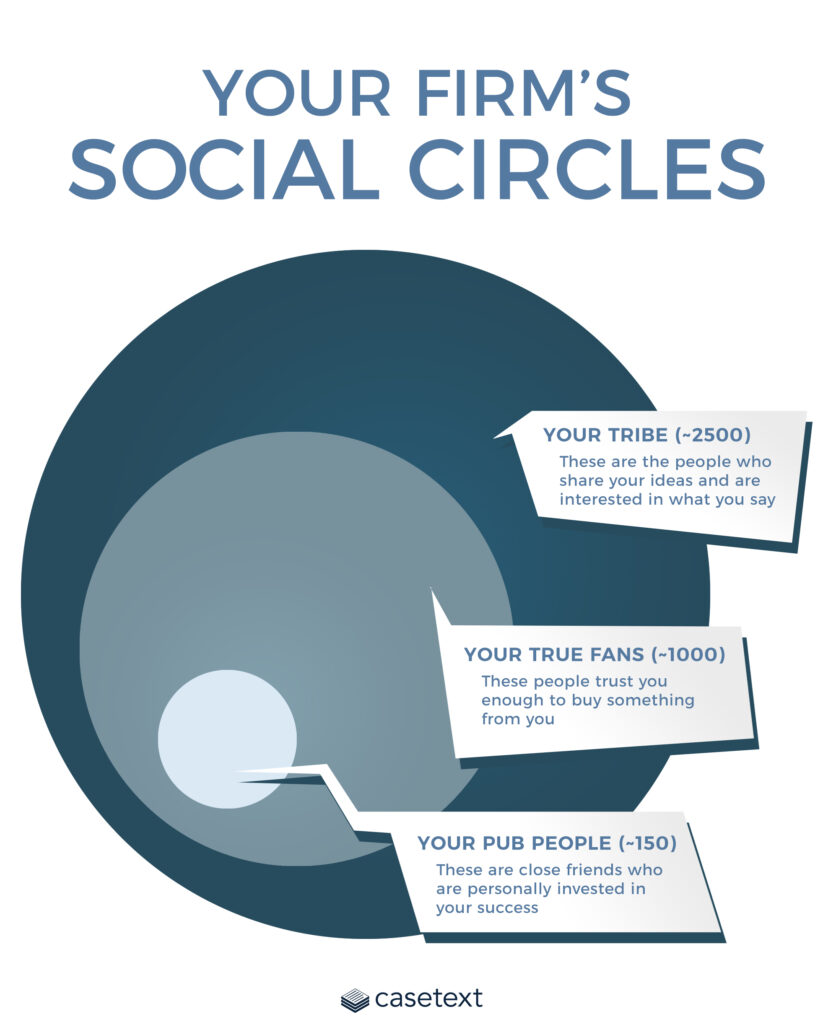
Alright, that all seems very esoteric, so let’s get practical.
Why do these social circles matter? In the context of better referral marketing, it’s because you’ve likely focused on the wrong group. That misdirected effort may have cost you the quality referrals your firm needs.
Remember that your marketing aim is to have as many uncomfortable conversations as possible, chats between people who care about your business and others who do not.
Rather than seeking to multiply those conversations, though, many solos focus entirely on nurturing paying customers. Yes, your True Fans are important, but remember that they pay you for solutions; they don’t feel personally invested in your success. That expectation is reserved for your Pub People.
To build that True Fans group, you’ll need to tend to your other social circles.
When you openly publish your views and beliefs (marketing work with fewer ethics-related blockages), your Tribe will gather around you. Your Pub People will then step in, turning interested Tribe members into paying Fans.
If all the social capital work you do is chasing and serving paying customers, you’re undermining your most profitable pipeline. So start rethinking your connections.
With those foundational truths in mind, let’s get on to the three-step process that’ll lead to a healthier referral system.
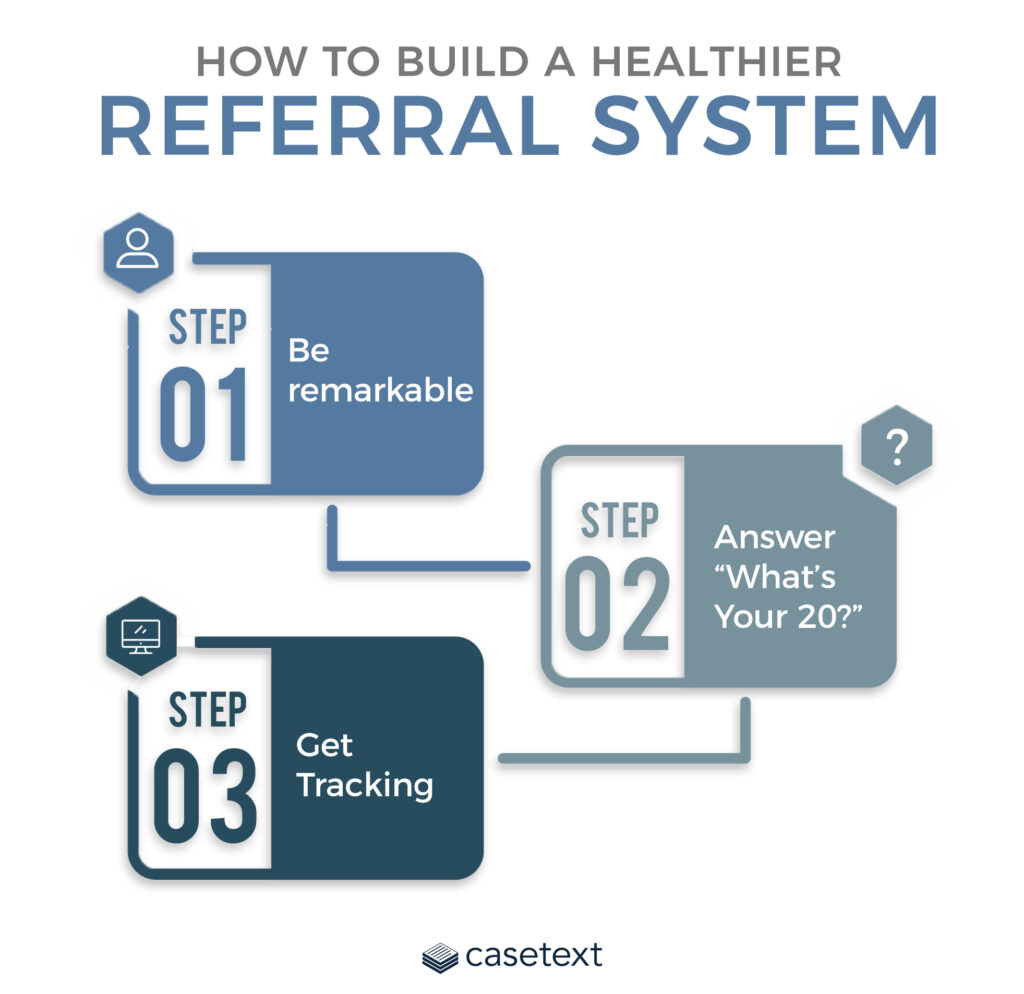
Remember the beginning of this article when we said cashflow is the #2 killer of small businesses? Know what #1 is?
According to CB Insights, the biggest killer of small businesses is “no market need.” It turns out that people have to want the thing you’re selling.
Perhaps that doesn’t surprise, but it impacts lawyering in an interesting way.
Lawyering comes with standards of practice. Some of those standards are explicit and taught in school while others are implicit and punished when not followed. In either case, the “product” comes to us fairly well-defined.
Certainly, law students also face the vaguer task of learning to “think like a lawyer,” but we don’t subject ourselves to $100,000+ in debt to simply become better citizens. The price tag comes with a promise: that we’d qualify to deliver a regulated service and make a living doing it.
The professionalization of legal services has brought a lot of good, but this product-first thinking also flies in the face of most modern business practice. Long before Eric Ries’ Lean Startup, business owners created ways to test demand in small batches.
You create something, you deliver it, you see how people respond, and then you either kill it or you make more. That’s the simple feedback loop that avoids the #1 killer of small businesses.
But our “product” is more or less handed to us. We can only deviate from it so much. So, if we can’t start from scratch like a “lean startup,” how does a solo lawyer stand out and meet the demand of particular audiences?
You have to find a way to be remarkable.
The surest test of whether your firm is remarkable is whether others are remarking you.
Today we think of a “remark” as a comment, but the older definition has to do with standing out, with others finding you worth talking about.
In short, if you’re not interesting, no one is going to have those uncomfortable conversations that convert lookers into buyers.
So where can lawyers apply their creative juices to make something worth talking about?
Maybe you change your pricing model the way Kim Bennett has; maybe you change the delivery method the way Erin Levine has; maybe you go for notoriety the way the Texas Law Hawk has; maybe you become a known expert the way David C Baker teaches; or maybe you build a talk-worthy level of service the way Paul Dunn and Ron Baker advise.
However you do it, create a story so unique that others want to share it.
Please don’t plug terms like “trustworthy” and “experienced” into your website theme. Everyone says that. It’s not remarkable.
Instead, start by building a firm worth talking about.
Once you’ve found ways to differentiate your firm from the crowd, start building a crowd of your own. Attract the group of advocates who’ll work hard to support you and your business.
As we discussed earlier, this is a matter of social capital. You want to nurture the group of people who are emotionally invested in your success. You need your Pub People, but you don’t have to wait until you can name 150 caring buddies.
Instead, answer the question “What’s your 20?”
In trucker talk, dispatchers ask drivers “What’s your 20?” to get a current location. In a similar way, you can accurately gauge your firm’s success location by identifying your “20,” in this case your twenty most reliable referral sources.
Twenty is a good number to start with for your new referral program. You could sit down in a couple of hours and think of twenty people who care enough about your business to engage in uncomfortable conversations with people who don’t care. You know twenty people who’ll prospect for you.
But, to be clear, these aren’t just any friends. As much as she wants me to succeed, my mom probably wouldn’t be a good member of my first twenty. Liking you doesn’t necessarily make someone a good advocate.
In picking your first twenty advocates, consider these questions:
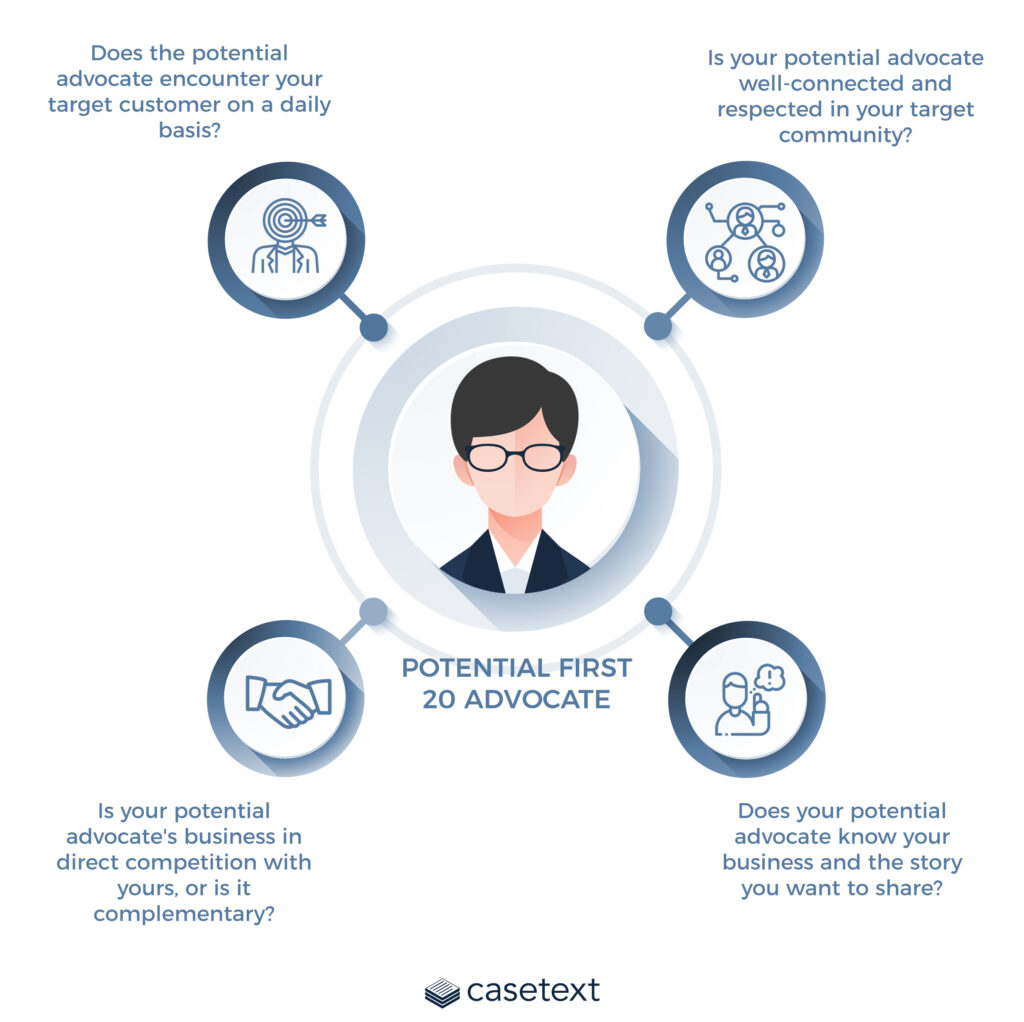
These are ideas rather than “rules,” but they’ll help you identify the twenty likeliest suspects to advocate for your firm.
When you choose your Twenty, be honest with them. Let them know that you want to grow your firm and could use their help. Tell them the important story you want shared about how your firm helps people. If these people are genuinely in your “Pub People” circle, they won’t find your transparency offensive at all. They’ll want to spread the good word.
After you’ve identified your Twenty advocates, asked for their help, and armed them with your story, it’s time to start tracking data.
At this stage in your referral marketing progress, you need ways to foster and evaluate your advocate connections.
The social capital exchange you want to track is comprised of two primary measurables:
Here are a couple of ways to keep track of those two crucial data points…
Any cloud-based CRM will help you effectively track your engagements with different contacts, including your Twenty, and the leads they produce.
With each new sale, you’ll identify where your latest prospect came from. A basic CRM will allow you to tag those prospects and thereby track how many leads are fed into your pipeline by a particular referral source.
And many of these basic CRM systems are free and quite robust. Take a look at what Hubspot’s free CRM tool includes…
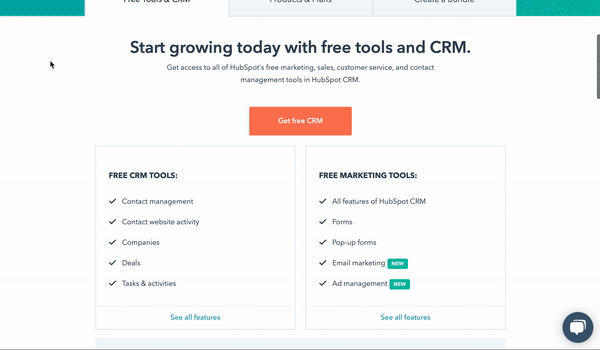
Other CRM systems offer different options at different rates. Here are a few that could work…

Clio Grow, formerly Lexicata, offers CRM and intake tools targeted specifically to small law firms. These tools are robust and easy to use. Clio Grow utilizes data-integrating intake forms, email and workflow automations, and electronic signatures. Because it’s now built on the Clio ecosystem, it integrates well with all of Clio’s partners.
Make sure you check out JurisPage’s review of Clio Grow here.

Zoho CRM was an early entrant into the online CRM world. The company has always focused on the small business market, which means it’s built upon ease-of-use. As with other CRMs, Zoho allows you to define the stages of your sales cycle and move prospects through each stage. It can be integrated with Zoho’s suite of additional products as you grow.
See Business.com’s review of Zoho CRM here.
My favorite small business-focused CRM is Hubspot. The company has long used its CRM to fill the purpose of Costco’s roasted chicken: a loss leader that gets people in the door. That means that the product is genuinely good (just look at the user ratings in the review below); it also means they’ll market other products to you down the road. The service and training that Hubspot provides for free is beyond compare. If you want to jump into a CRM, this is probably the one.
Take a look at user reviews on Capterra here.
Every one of the CRMs listed above will move your prospecting efforts forward, including your referral marketing strategy. And, frankly, there are many others that will perform just as well.
The problem, as usual, is that you’ll have one more piece of software to learn. Solo attorneys don’t have a lot of time to add software costs and learning curves without results, so let me propose a simpler method…

Remember that your tracking system only needs to monitor two primary measurables:
To avoid overcomplicating your first steps to better referrals, we’ve developed a simple worksheet that you can use to track your Twenty.
Download a copy of the What’s Your Twenty Worksheet by clicking the button below…

Now let’s walk you through the Worksheet so you can tend to your Twenty better.
The first section of the What’s Your 20 Worksheet asks for the name and contact information of each of your Twenty. You could certainly store this in other places, and you probably will, but having that information at hand will help you when it comes time to follow up.

The second section of the What’s Your 20 Worksheet allows you to track “touches” throughout the year.
Remembering that your Twenty is a subset of your Pub People, you know that you have to do some upkeep. You can’t send a random holiday card and hope that these people will love you enough to have uncomfortable conversations.

Stay in frequent contact with your Twenty and hold yourself accountable by documenting the interactions. Track the touches that mean most to you, but we’d suggest these few options:
Definitely add or subtract from our list if you’d prefer different touches, but make sure you stay in frequent contact.
One other important point: actual touches generally work best. As Robin Dunbar taught, human touch is crucial for this “Pub People” level of bonding, so shake some hands and kiss some babies.
The third section of the What’s Your 20 Worksheet asks for results. Who in your Twenty brought in the most prospective clients? How many of those referrals actually retained you? What were those cases worth?
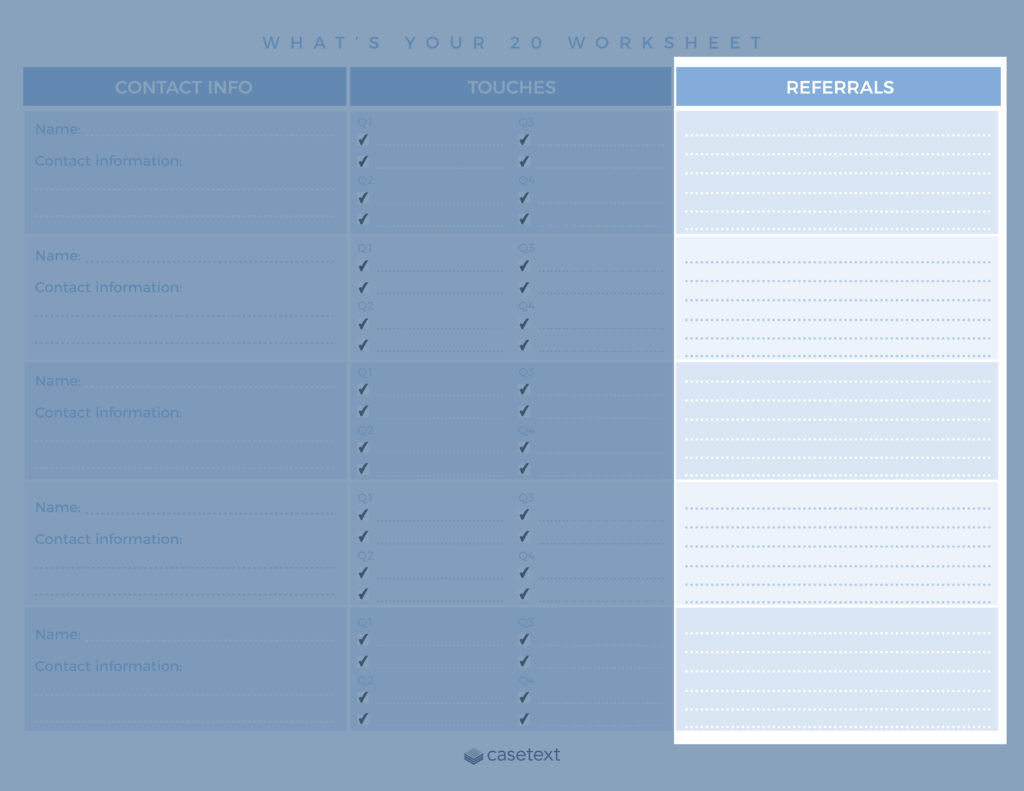
This data will help you develop your referral program in the future. You’ll likely find that a couple of your connections bring you the vast majority of your referrals, or the majority of profits. That will help you refocus your efforts next year.
Every year you’ll be able to build upon this list of Twenty.
And I don’t want to overpromise – if all you do is develop a team of twenty advocates, you won’t solve all of your revenue problems. Our purpose here is to develop a system and a habit.
Over time you’ll begin to see patterns in your What’s Your 20 Worksheet. You’ll see who’s connecting you to the most people, and in your next iteration you’ll know to focus on that group.
What makes your best referral sources the best? What are the common characteristics? Can you identify anyone else in your Pub People circle who also have those characteristics? If so, recruit them and test again.
But keep track of even the lower-performing referral sources. Maybe you take them for burgers rather than lobster for your quarterly lunches, but every advocate deserves your personal attention.
These advocates will be the army you can’t be. They’ll have the uncomfortable conversations that ethics rules and a busy schedule make harder on you. They will fill the pipeline of your firm.
Once they do, honor them by going the extra mile for referred clients. Your friends put their reputations on the line for you. Show them that they chose wisely.
With each successive act of kindness, you’ll have built a group loyal to you and your business.

Rapidly draft common legal letters and emails.
How this skill works
Specify the recipient, topic, and tone of the correspondence you want.
CoCounsel will produce a draft.
Chat back and forth with CoCounsel to edit the draft.
Get answers to your research questions, with explanations and supporting sources.
How this skill works
Enter a question or issue, along with relevant facts such as jurisdiction, area of law, etc.
CoCounsel will retrieve relevant legal resources and provide an answer with explanation and supporting sources.
Behind the scenes, Conduct Research generates multiple queries using keyword search, terms and connectors, boolean, and Parallel Search to identify the on-point case law, statutes, and regulations, reads and analyzes the search results, and outputs a summary of its findings (i.e. an answer to the question), along with the supporting sources and applicable excerpts.
Get answers to your research questions, with explanations and supporting sources.
How this skill works
Enter a question or issue, along with relevant facts such as jurisdiction, area of law, etc.
CoCounsel will retrieve relevant legal resources and provide an answer with explanation and supporting sources.
Behind the scenes, Conduct Research generates multiple queries using keyword search, terms and connectors, boolean, and Parallel Search to identify the on-point case law, statutes, and regulations, reads and analyzes the search results, and outputs a summary of its findings (i.e. an answer to the question), along with the supporting sources and applicable excerpts.
Get a thorough deposition outline in no time, just by describing the deponent and what’s at issue.
How this skill works
Describe the deponent and what’s at issue in the case, and CoCounsel identifies multiple highly relevant topics to address in the deposition and drafts questions for each topic.
Refine topics by including specific areas of interest and get a thorough deposition outline.
Ask questions of contracts that are analyzed in a line-by-line review
How this skill works
Allows the user to upload a set of contracts and a set of questions
This skill will provide an answer to those questions for each contract, or, if the question is not relevant to the contract, provide that information as well
Upload up to 10 contracts at once
Ask up to 10 questions of each contract
Relevant results will hyperlink to identified passages in the corresponding contract
Get a list of all parts of a set of contracts that don’t comply with a set of policies.
How this skill works
Upload a set of contracts and then describe a policy or set of policies that the contracts should comply with, e.g. "contracts must contain a right to injunctive relief, not merely the right to seek injunctive relief."
CoCounsel will review your contracts and identify any contractual clauses relevant to the policy or policies you specified.
If there is any conflict between a contractual clause and a policy you described, CoCounsel will recommend a revised clause that complies with the relevant policy. It will also identify the risks presented by a clause that does not conform to the policy you described.
Get an overview of any document in straightforward, everyday language.
How this skill works
Upload a document–e.g. a legal memorandum, judicial opinion, or contract.
CoCounsel will summarize the document using everyday terminology.
Find all instances of relevant information in a database of documents.
How this skill works
Select a database and describe what you're looking for in detail, such as templates and precedents to use as a starting point for drafting documents, or specific clauses and provisions you'd like to include in new documents you're working on.
CoCounsel identifies and delivers every instance of what you're searching for, citing sources in the database for each instance.
Behind the scenes, CoCounsel generates multiple queries using keyword search, terms and connectors, boolean, and Parallel Search to identifiy the on-point passages from every document in the database, reads and analyzes the search results, and outputs a summary of its findings (i.e. an answer to the question), citing applicable excerpts in specific documents.
Get a list of all parts of a set of contracts that don’t comply with a set of policies.
Ask questions of contracts that are analyzed in a line-by-line review
Get a thorough deposition outline by describing the deponent and what’s at issue.
Get answers to your research questions, with explanations and supporting sources.